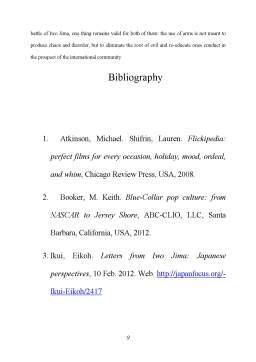Extras din referat
In this present paper I will discuss two movies that have a deep and strong message engraved both in America’s heart, as well as in Japan’s honor. “Letters from Iwo Jima” & “Flags of Our Fathers” is my selection for this paper, because both movies are interesting, moreover they reflect the battle over Iwo Jima Island from their own perspective. The message is clear if we think that the action occurs during the Second World War, more precisely a message of anti-war. Both films are directed by Clint Eastwood and if we think of these movies chronologically, we are obliged to say that “Letters of Iwo Jima” appeared later as it was the wish of Eastwood’s determination to “prepare” a counterpart of his American version of “Flags of Our Fathers”. I’ve watched “Letters from Iwo Jima” countless times and I liked it each time I’ve seen it, but I have to confess that “Flags of Our Fathers” was less thrilling than the Japanese version of this war.
The fact of the matter is that I will be relatively bias towards one movie, though I shall provide for this essay both perspectives in order to highlight the hardships encountered by both camps. So, if we are talking about two perspectives, I think it would be fair enough to emphasize the opinion of a Japanese audience for “Letters from Iwo Jima” and an American opinion regarding “Flags of Our Fathers”.
Before I go on with my film analysis, I would like to describe the event as how truly happened in history. It would be useful for the reader to actually get accustomed with the event and have a clear image of this battle in order to understand the two films.
The Battle of Iwo Jima occurred during World War II, more precisely from February to March 1945 and the island was considered to be an important strategic move. For both sides, the purpose was to occupy this island in order to diminish the power of the enemy. It’s a bit amusing because of the actual size of the island which measured only 8 square miles, nevertheless its size was not the main concern, but the issue of controlling it was most essential. As in the American version of the movie, the victory of the Americans was marked by the hoisting up of the American flag on Mount Suribachi. It was not an easy victory, because the Japanese were known for their fierce defensive strategies and they resisted a lot before they had to give up the fight due to the high number of American soldiers. But the Americans fought against them with all they’ve had and the reason for their victory was the fact that they received medical units, military weapons and bombs very frequently, whereas the Japanese did not receive any help from the mother country. So it was necessary to conquer Iwo Jima because otherwise the Japanese would pose a serious threat by launching a bombing campaign.
The advantage of the American army was reflected in the lack of Japanese naval and aircraft power and because the Japanese had only ground soldiers, it was pretty easy for them to launch harsh attacks on their base. But this lack of the Japanese army was soon to compensate by their string willed determination to have undefeatable defensive. But aside from their strong defensive, the Japanese had a radar outpost which detected an attack attempt 2 hours in advance so that they will have time to launch a counterattack. All in all, it was an effort to control the island and the Americans succeeded in their attempt to capture the island.
Bibliografie
1. Atkinson, Michael. Shifrin, Lauren. Flickipedia: perfect films for every occasion, holiday, mood, ordeal, and whim, Chicago Review Press, USA, 2008.
2. Booker, M. Keith. Blue-Collar pop culture: from NASCAR to Jersey Shore, ABC-CLIO, LLC, Santa Barbara, California, USA, 2012.
3. Ikui, Eikoh. Letters from Iwo Jima: Japanese perspectives, 10 Feb. 2012. Web. http://japanfocus.org/-Ikui-Eikoh/2417
Preview document
Conținut arhivă zip
- Film Study Comparison Between Letters From Iwo Jima and flags of our Fathers.docx









